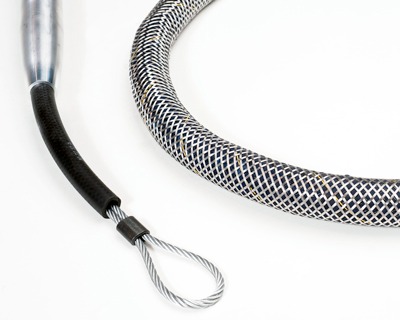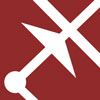The MATCOR Gopher family of products is growing! We are pleased to introduce MitiGopher™, MATCOR’s proprietary AC Mitigation System for HDD installation applications.

In 2014, MATCOR introduced the Iron Gopher® version of its SPL™-FBR linear anode – the only linear anode specifically designed for use in HDD pulling installations features a patented stainless steel overbraid and an integral steel pulling cable to significantly improve the mechanical pulling strength of the linear anode for difficult or critical installations.
We have extended this innovation to our engineered AC Mitigation grounding Mitigator® product offering as we introduce the MitiGopher. As with our Iron Gopher linear anode, the MitiGopher features a stainless steel overbraid and internal pulling cable to improve the product durability when being installed by HDD pulling.
Horizontal directional drilling (HDD) is a challenging and difficult method of installation. It is not possible to eliminate all risks during installation – the installer is cautioned that any fabric encased backfilled linear product (linear anode or engineered grounding system) will break when pulled too hard. The Gopher family of products are specifically designed to have a much stronger pulling strength than MATCOR’s standard linear products. This additional pulling strength allows these products to be installed in broader range of HDD applications. This does not mean that every HDD application can be successfully pulled using the Gopher family of products and, in some cases, even the Gopher can be damaged during HDD installations.
Iron Gopher and MitiGopher Installation Guidelines
Below you will find our guidelines for a successful HDD installation of the MitiGopher AC Mitigation System and the Iron Gopher cathodic protection system.
Site Geotechnical Investigation
Any discussion about horizontal directional drilling installation starts with a site geotechnical investigation. Obtaining a geotechnical survey or as much geological information about the respective job site is very important. A great amount of record information is available through sources including:
- United States Geological Society (USGS)
- National Geological Map Database
- Publications of the US Army Corps of Engineers
- Earth Explorer
- The National Soil Survey Center (NSSC) a division of the US Department of Agriculture
- State Departments of Transportation
- Highway Administrations
- Original construction records
In addition to record information, site-specific investigations (soil bores and soil sampling) by trained geologists and geotechnical service companies can provide valuable detailed data on the planned bore area geology. The geotechnical analysis should identify a number of relevant items including:
- Soil identification along the bore route to locate rock, rock inclusions, gravely soils, loose deposits, discontinuities and hardpan
- Soil strength and stability characteristics
- Groundwater
Local drillers with experience in the identified area can often provide valuable insight based on similar projects in the same area.
Terrain and HDD Route Mapping
Collecting accurate topographical information of the bore route is another critical component in the planning phase. Terrain and HDD mapping includes determining HDD bore hole entrance and exit locations, identifying and mapping elevation profile changes, ensuring that other utilities are appropriately identified and avoided, assessing the need for traffic control, evaluating any environmental considerations or limitations that might impact the use of drilling muds and hole conditioners.
Bore Planning Software
Several commercial bore planning software tools are available to assist in the planning phase. These programs utilize the soil and geotechnical data combined with the terrain and route mapping information to provide a graphic visualization of the job helping the driller more accurately “see” and perform the job from start to finish. These software tools help the contractor select the appropriate drill rig, drill bit type and backreamer based on the anticipated soil conditions and the total bore length. By choosing the drill stem and length, the desired bore path depth, desired minimum cover, diameter and bend radius of the product being pulled, the software plots a proposed bore pitch, calculates setback distances, figures point to point bore paths, estimates hole volumes and calculates pullback time. The software can also provide a fluid–mixing process map that shows how much mud should be used based on soil conditions, drill unit and tooling used.
If a bore planning software package is not used, field calculations should be performed to appropriately choose the correct drill rig, drill bit and backreamer tooling requirements, desired bore path and quantity and type of drilling fluids to be utilized.
Linear Product Selection Guidelines
MATCOR manufactures two types of linear products (standard fabric housing and the stainless steel over braided Gopher family of products) that are both, in the right circumstances, suitable for use in HDD installations. Each has its limitations. The installation contractor, along with the client, must carefully select the appropriate product type and the appropriate installation methodology. The two generally accepted methodologies are direct pulling of the linear assembly through the properly conditioned borehole by attaching the assembly to the backreamer after the initial pilot hole has been drilled. The second installation methodology involves pulling an HDPE pipe sleeve into the borehole, installing the assembly inside the pipe, and then removing the HDPE sleeve. The tables that follow are intended to assist the installer in selecting the appropriate product configuration and installation methodology. The selection of the appropriate anode type and installation methodology is subjective based on a qualitative analysis.
TABLE 1 – Application Difficulty
| EASY | Less than 200 foot pulling length Minimal changes in elevation No environmental restrictions on use of drilling muds/hole conditioners Installation costs and risks are low |
| MODERATE | 200-500 foot pulling length Moderate elevation change No environmental restrictions on use of drilling muds/hole conditioners Installation costs are modest and risks are low |
| DIFFICULT | 500-1000 foot pulling length Moderate elevation changes Some environmental restriction on use of drilling muds/hole conditioners Installation costs are higher and risks are moderate |
| EXTREME | 500+ foot pulling length Extreme or multiple elevation changes Restrictive environmental limits on use of drilling muds/hole conditioners Critical application with high costs and risks |
TABLE 2 – Product Type Selection Guidelines
| Application Difficulty1 | ||||
| SOIL TYPE | EASY | MODERATE | DIFFICULT | EXTREME |
| Earth Loams | Fabric | Fabric/Gopher | Gopher | Gopher* |
| Sand/Silt | Fabric/ Gopher | Gopher | Gopher | Gopher* |
| Clay | Gopher | Gopher | Gopher* | Gopher* |
| Gravel / Cobble | Gopher | FBR*/ Gopher* | Gopher* | Gopher* |
| Rocky | Fabric*/Gopher* | Fabric*/Gopher* | Gopher* | Gopher* |
* Assembly is to be installed in HDPE sleeve that is then removed
Notes
- Classifying the linear anode application difficulty using Table 1 is a qualitative analysis and may warrant taking into consideration other risk factors that may be appropriate. In general, the more difficult the application, the more costly the installation component, the greater the case to use the higher pulling strength Gopher and the greater the incentive to use temporary HDPE sleeving to assure the lowest risk installation.
- Soil Types based on the US Department of Agriculture Soil textural classification guidelines. Earth Loams would include the broad range of Sandy Clay Loam, Loam, Silt Loam, and Clay Loam.
Contingency Planning
Even with proper project planning and an experienced installation contractor, some consideration should be given to contingency plans in the event that something unforeseen happens during the HDD boring and anode installation.
- Are alternate bits available if needed to complete the pilot hole?
- Is a larger boring machine available if needed?
- If drilling is more challenging than anticipated do we have ready access to HDPE pipe for sleeving if warranted?
- Does the project warrant having one or more spare anode assemblies in the event of an anode breakage during installation?
While these risks can be greatly minimized with proper planning, asking these questions before mobilizing to the site can help solve problems more quickly, saving time and money.






